Site Search
- resource provided by the Forum Network Knowledgebase.
Search Tip: Search with " " to find exact matches.
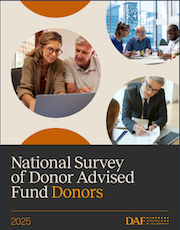
This report offers a comprehensive look into the characteristics and perspectives of individuals and families who utilize DAFs for their charitable giving in the United States. The study surveyed over 2,100 DAF donors, focusing on their demographics, financial characteristics, giving patterns, decision-making processes, motivations for using DAFs, and the role of DAFs in their overall philanthropic strategy.
Mismatched: Philanthropy’s Response to the Call for Racial Justice is the most comprehensive assessment of racial equity and racial justice funding to date, providing a detailed analysis of funding from 2015–2018 and a preliminary analysis for 2020. Written by Malkia Devich Cyril, Lyle Matthew Kan, Ben Francisco Maulbeck, and Lori Villarosa, the report examines trends, contradictions, and divergences in funding for both racial equity and racial justice work.
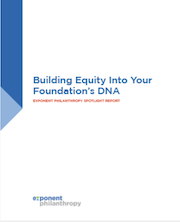
Funders are being asked to show how they are addressing social inequities by specifying what they do and who they are. How does philanthropy begin to embed equity into grantmaking, policies, and culture?
Healthy Communities Foundation has been on a journey to address this question by advancing health equity through a racial equity lens. This report describes that journey and offers practical ways of inspiring action so you can integrate equity into your foundation’s DNA.
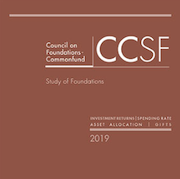
The CCSF report is the field’s most comprehensive and authoritative study on investment and governance policies and practices. The 2019 CCSF studies 265 private and community foundations that represent $104.7 billion in assets. Topics covered include:
- Returns and Investment Objectives
- Asset Allocation and Responsible Investing Criteria
- Responsible Investment Practices
- Fund Flows, Spending and Gifts
- Resources, Management and Governance
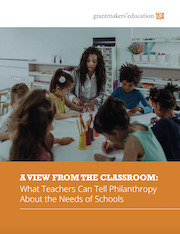
What can over a million teachers tell us about the needs of schools? This report digs into the data from 1.8 million teacher requests on the crowdfunding site DonorsChoose to tell the story from inside today's classrooms. We feel this data provides a roadmap for funders seeking to support students directly, but also for funders seeking broader reform of U.S. education policy and systems.
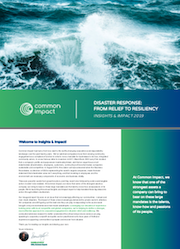
There is a stronger, more strategic role that companies can play by leveraging skills-based volunteering to invest in a community’s resilience.
This report shares the findings, an approach and practical tools to enable companies to tap into the skills and know-how of their employees and equip our communities to anticipate, survive and bounce back from disaster.
It’s well established that employee engagement, defined as a willingness to do more than the job minimally requires, drives corporate performance. This report examines one potential driver of employee engagement - corporate volunteering, defined as employer-organized opportunities for employees to support a charitable cause or otherwise make a positive social impact with their contribution of time.
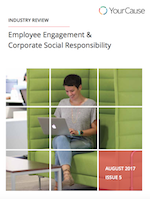
Twice a year, the YourCause team publishes our Industry Review focused on evaluating employee engagement and corporate social responsibility programs. This report uses performance data collected by the YourCause Employee Engagement platform between January and December of 2016. We identify trends, activities and benchmarks in employee engagement and corporate social responsibility. Our clients, industry peers, and other interested parties may use this data as a barometer for performance measurement.
On October 5, 2015, Building Public-Private Partnerships to Enhance Disaster Resilience: A Listening Session was convened by the Office of the Assistant Secretary for Preparedness and Response (ASPR) Division for At-Risk Individuals, Behavioral Health, and Community Resilience (ABC)and co-hosted with Grantmakers In Health (GIH). This is a summary of the final meeting report.
Low levels of diversity in the senior ranks of foundations have proven to be a stubborn challenge for the field of philanthropy. A newly-released report by Forward Change takes an important step toward a deeper understanding of the career pathways of professionals of color in philanthropy—how they enter foundations, how they advance across their careers, and what factors affect their advancement within the sector.
The Kearny Bank Foundation donated a total of $735,500 to various charities in 2023 — increasing its five-year giving total to more than $3.6 million, the bank reported this week.
In 2023, the largest single donation was to Junior Achievement of New Jersey, which received $140,000.
The Devils Youth Foundation, in an effort to bring life-changing opportunities to New Jersey’s youth through the power of sports and entertainment, recently committed its largest-ever grant, $100,000, to foundation partner La Casa de Don Pedro.
The grant provides the La Casa de Don Pedro facility with a brand new “El Patio de La Casa” — a revitalized area to serve as a vibrant community hub modeled after a Caribbean Plaza with safe spaces for children to play, attend concerts, have a neighborhood communal refrigerator and enjoy festivals.
El Patio de La Casa’s subsequent community programming will serve over 800 youth in Newark annually.
Rising Tide Capital (RTC), a prominent New Jersey-based entrepreneurship training organization, has received a transformative three-year, $1.5 million grant from the Geraldine R. Dodge Foundation to catalyze the nonprofit’s programmatic expansion in Trenton and throughout New Jersey. This award, approved by the Foundation’s Board of Trustees, will provide $500,000 annually to advance RTC’s impactful entrepreneurship education and workforce development initiatives catering to historically marginalized communities.
The Dodge Foundation’s strategic investment will bolster entrepreneurship education centered on high-opportunity licensed, credentialed, and certified career pathways. It will also provide comprehensive one-on-one technical assistance, resilience coaching, and tailored business support to entrepreneurs. Furthermore, the grant will fund strategic innovation projects that integrate RTC’s established programs with statewide partners, thereby significantly expanding the reach and accessibility of services to underserved communities throughout New Jersey.
A CNJG member received an application from a school district, and wanted to know if others granted funds to a school district, and what other funders learned from granting to a district.
Strategic asset allocation is arguably one of the most important, yet least advanced, aspects of investing. The Investment Strategy Group (ISG) in the Goldman Sachs Investment Management Division has developed a new approach to strategic asset allocation, which leverages the idea that long-term investment returns derive from multiple distinct sources called “return-generating factors.” This multi-factor approach is designed to help investors better understand the key sources of long-term return across asset classes and to increase the precision of long-term risk and return estimates. It also provides investors with a new way to think about portfolio diversification, allowing them to focus not only on diversification across asset classes but also
on diversification across the underlying sources of return.
